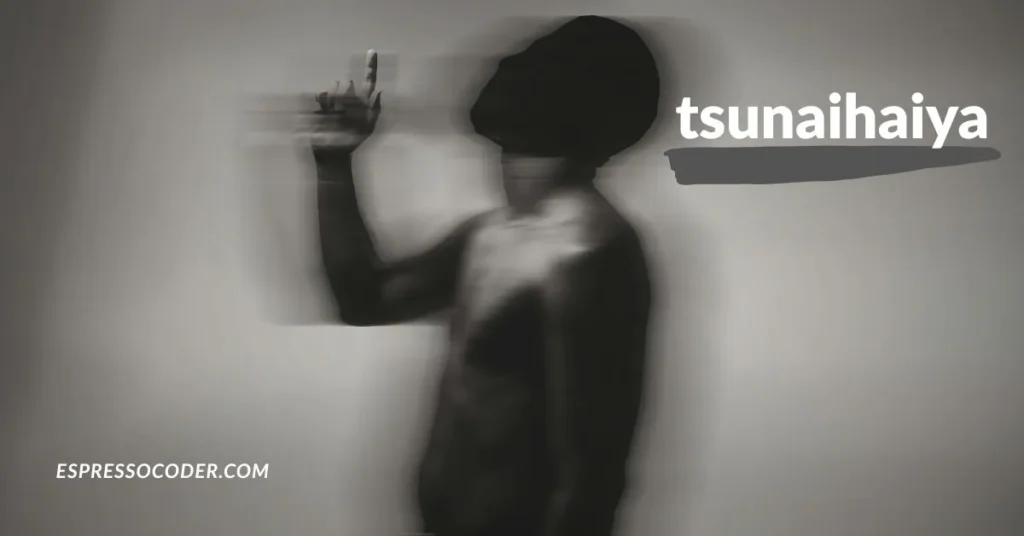Contents
- Quick answer
- What Is Tsunaihaiya? An Emotional Symbol in Digital Culture
- Key Facts About Tsunaihaiya
- Why Is Tsunaihaiya Gaining Attention?
- Origins of Tsunaihaiya
- How Is Tsunaihaiya Used Online?
- Emotional and Philosophical Meaning
- Mythic Role in Fiction and ARG
- Comparison to Other Untranslatable Words
- Tsunaihaiya in Creative Writing and Education
- Why Do People Resonate with Tsunaihaiya?
- The Future of Words Like Tsunaihaiya
- Conclusion
- FAQs
Quick answer
Tsunaihaiya is a digitally coined term expressing emotional ambiguity, identity, and artistic mood. It holds no official dictionary definition but signals nuanced feelings or creative expression in online communities. Used across social platforms, it’s a cultural invention rooted in digital art, language evolution, and emotional communication.
What Is Tsunaihaiya? An Emotional Symbol in Digital Culture
Tsunaihaiya is a newly emerging word with no roots in traditional language. It’s a coined term born from digital art communities, alternate reality gaming (ARG), and creative subcultures. People use it to express moods, signal digital identity, or title abstract content that defies clear classification.
Its rise signals a growing trend: language created by users, for users.
Hook:
Tsunaihaiya might just be the word your feelings have been looking for.
Key Facts About Tsunaihaiya
| Feature | Description |
|---|---|
| Origin | Digital subcultures, post-2017 |
| Usage Platforms | TikTok, Discord, Instagram, Reddit, NFT forums |
| Primary Function | Expressing emotion or identity; placeholder for abstract feelings |
| Language Type | Invented, post-linguistic |
| Phonetic Style | Chant-like: tsu-nai-hai-ya |
| Cultural Role | Digital shibboleth; emotional symbol in niche communities |
Why Is Tsunaihaiya Gaining Attention?
Expresses Complex Emotions
Tsunaihaiya acts like a vessel for emotions that traditional words can’t hold. Think of it like digital-era saudade—a word for longing, ambiguity, or emotional overflow.
Resonates with Digital Identity
Users often embed the word in usernames, captions, or video overlays. It signals that the person operates in a reflective, creative, or post-mainstream digital space.
Flexible and Contextual
Unlike dictionary-defined words, Tsunaihaiya adapts to its environment. In a photo caption, it could mean rebirth. In a TikTok voiceover, it might reflect disconnection.
Origins of Tsunaihaiya
No Known Language Roots
The word mimics Japanese-sounding phonemes, but it’s not Japanese. It combines syllables that feel fluid, rhythmic, and emotionally charged.
Possibly Born in ARG and Art Forums
Some online users suggest the earliest uses were in ARG fiction communities. Others say it appeared in generative art tags on Tumblr and Instagram post-2017.
Sound Symbolism in Action
It reflects what linguists call sound symbolism: when a word’s sound evokes meaning, even if the word is made-up. “Tsunaihaiya” sounds like a breeze, a chant, or a whispered idea.
Also read:https://espressocoder.com/pyntekvister/
How Is Tsunaihaiya Used Online?
Used as captions for moody or abstract visual content:
- Faces in shadows
- Light refracting through water
- Hashtag: #tsunaihaiya #unfinished
TikTok
Voiceover paired with:
- Lo-fi beats
- Glitchy animation
- Soft ASMR storytelling
Discord
- Used in usernames: Tsunaihaiya_88
- Shared as an in-group expression or aesthetic marker
Appears in linguistics, culture, or speculative meme threads. Users explore its role in post-linguistic communication.
NFT and Generative Art Communities
Titles of:
- Fragmented memory pieces
- AI-generated landscapes
- Audio-visual experiments
Emotional and Philosophical Meaning
Ambiguity as Strength
Tsunaihaiya holds emotional tension. It may signal:
- Yearning with peace
- Sadness without grief
- Identity without labels
Symbolic of the Post-Language Age
As people increasingly code-switch between emojis, memes, and mixed languages, Tsunaihaiya feels natural. It represents the limits of language—and what comes next.
Floating Signifier
A term used in semiotics: something that has no fixed meaning, but accumulates power by being interpreted.
Mythic Role in Fiction and ARG
Tsunaihaiya is not just a word—it’s becoming a legend.
- Name of a lost digital place
- Sound whispered in dream-based storytelling
- Fragment appearing in broken AI dialogue
- Part of fantasy world-building lexicons
This mythopoeic quality extends its lifespan and symbolic weight.
Comparison to Other Untranslatable Words
| Word | Origin | Meaning | Similarity to Tsunaihaiya |
| Saudade | Portuguese | Longing for something absent | Emotional ambiguity |
| Hiraeth | Welsh | Homesickness for a possibly unreal home | Nostalgic but abstract |
| Sehnsucht | German | Yearning for an ideal that’s unreachable | Philosophical emotion |
| Komorebi | Japanese | Light filtered through trees | Visual-poetic fusion |
| Tsunaihaiya | Invented | Undefined emotion, memory, or creative rhythm | All of the above, digitally expressed |
Tsunaihaiya in Creative Writing and Education
- Creative prompts: Writers use it as a starting point for flash fiction.
- AI training input: Language model creators use it to inspire emotion-rich outputs.
- Classroom activities: Students invent meanings and context for abstract invented terms.
- Emotional literacy workshops: Facilitators explore how such words help people articulate feelings.
Why Do People Resonate with Tsunaihaiya?
- It lets users feel without over-explaining.
- It signals identity in a fragmented digital world.
- It fills emotional and linguistic gaps.
- It adapts—fluid, poetic, and free of boundaries.
In short, it speaks to the complexity of being human—online.
The Future of Words Like Tsunaihaiya
- Emerging digital lexicons: User-generated dictionaries for invented emotional terms.
- Cross-cultural expression: Words like Tsunaihaiya might inspire similar terms globally.
- AI interpretation models: Systems that understand or even speak in invented symbolic language.
- Multimedia art forms: Sound, light, and word art coalescing around invented words.
Tsunaihaiya may not be in the dictionary—but it is in the culture.
Conclusion
Tsunaihaiya isn’t about clarity—it’s about presence. It offers a way to say what can’t be said and feel what can’t be named. As language evolves online, such terms may define how we communicate next.
FAQs
What does Tsunaihaiya mean?
It’s an invented term used to express emotional depth, creative ambiguity, or philosophical feeling online.
Where did Tsunaihaiya originate?
From digital art and ARG communities, with stylistic roots in constructed language.
How is Tsunaihaiya used online?
In usernames, art captions, music videos, and fiction writing—especially to express mood.
Is Tsunaihaiya part of any real language?
No. It’s an invented word shaped by internet culture, not tied to any specific national language.
Why do people connect with Tsunaihaiya?
Because it leaves space for interpretation, reflection, and unspoken emotion.

